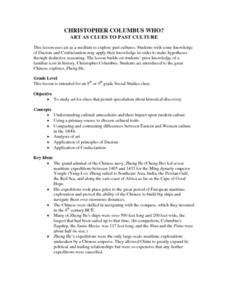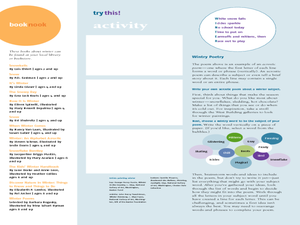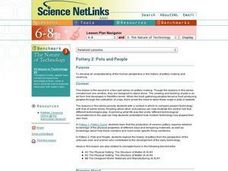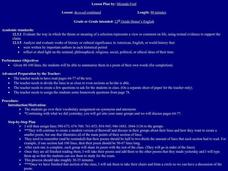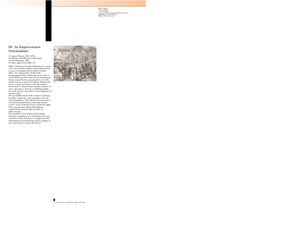Curated OER
Christopher Columbus Who?
Learners recreate a "60-minutes" interview using cue cards and historical information on the Chinese explorer Zheng He. This instructional activity is an excellent introduction to World History during the 1400's.
Curated OER
Hendrick Avercamp and the Winter Landscape
Students study the winter landscape art of Hendrick Avercamp. In this art history lesson, students read passages about the art and artist Hendrick Avercamp. Students learn about winter landscape art and write an acrostic poem about a...
Curated OER
Nonviolent Protest Around the World
Twelfth graders complete research that exposes them to examples of nonviolent protest throughout the modern world. In this nonviolent protest research lesson, 12th graders discover information about signification nonviolent movements...
Curated OER
Pots And People
Pupils compare present technology with that of earlier times. They explore the history of pottery from the perspective of the unknown men and women who contributed to the development of the early technology.
Curated OER
What's So Nice About Fairy Tales?
Seventh graders modernize a fairy tale, then compare their version with he original version and determine whether or not they've changed the author's original intent.
Curated OER
Beowulf
Learners read selections from Beowulf and summarize the poetry selections in their own words. Students discuss the poem, then create a modern version of Beowulf by using their own words and their own poetic form.
Curated OER
The Olympic Games
Students research the history of the Olympics and the various countries that have hosted the games. They obtain information about some of the sports featured in the Olympics. Students then create a brochure using Microsoft Publisher.
Curated OER
Land Use and Lawmaking in California
Students read writings by Ralph Waldo Emerson to analyze transcendentalism and analyze photographic essays depicting environmental issues. In this art and history lesson, students read excerpts of Nature by Emerson to identify...
Curated OER
Trip to Mount Vernon
Students compare and contrast travel in the 18th century with current methods of travel by participating in a simulated trip to Mount Vernon. In this US history lesson plan, students write a letter to George Washington for permission to...
Curated OER
Dance Research Essay
Students discover and appreciate the history, characteristics, and significance of a specific dance style. They to pick a dance style that they are interested in and would like to research.
Curated OER
Prometheus, the Firebringer
Students explore the world of Greek mythology by studying briefly each of the Gods.
They explore the visual world of Greek mythology in ancient art and architecture and create original play-lets based on authentic myths through creative...
Curated OER
Maine: A Place Apart?
Students list phrase that describe Maine from both an insider's and outsider's point of view. They create an exhibit on Maine's history and write an essay about Maine's image as "a place apart."
Curated OER
Torn Paper Collage Portrait
Young scholars watch demonstrations on how to create a collage out of different materials. Using town paper, they create their self-portrait and view art by Andy Warhol and Roy Lichtenstein. To end the lesson, they discuss a career in...
Curated OER
Flowers Galore
Students create original works of art using their knowledge of Georgia O'Keeffe's artwork, flowers, pencils, crayons, and pastels in this K-6 Art instructional activity. The instructional activity includes Georgia O'Keeffe resource...
Curated OER
The Red Studio Turns 100!
Students observe the art of Henri Matisse and discuss the ideas and feelings his art brings about. In this Henri Matisse lesson plan, students look at many of his artistic paintings and discuss and write in a journal the point of view...
Curated OER
Ancient Greece: Inquiring Minds Want to Know
Second graders explore world history by writing newspaper articles. In this Greek history lesson, 2nd graders investigate the geography and society of Ancient Greece by utilizing the Internet as a research tool. Students collaborate with...
Curated OER
Similarities Between African Folktales And French Folktales
Students study the importance of the Storyteller in ancient times as well as in modern times. They realize that this is an art essential to the development and evolution of the mind and that today more than ever we need to rely on...
Curated OER
Orientalism
Students read information about Orientalism, the artists who painted in that style, and study examples of the art. In this art style lesson plan, students read about the periods of Orientalism and the artists who created with the style....
Curated OER
Amelia Earhart: Aviation Pioneer
Students explore social practices and technological advancement of the 1920s and 1930s and relate this to modern life. They explore the events of Amelia Earhart's life and her poetry. They write their own poetry.
Curated OER
Japanese Haiku and the American Experience
Twelfth graders research the history to Haiku Poetry. They read classical haiku to comprehend their special sensibility and form. Students encounter the Buddhist philosophical background of this poetry and its roots. They write original...
Curated OER
Whitman and Lincoln
Young scholars determine if Lincoln and Whitman ever met and write a dialogue between the two men. In this Whitman and Lincoln lesson, students read Whitman's poem "Beat! Beat! Drums!" and connect it to the events of Lincoln's...
Curated OER
Male Nok Head SculptureNigeria, Africa
Sixth graders create sculpture. In this visual arts lesson, 6th graders design and create Nok sculptures that feature patterns and textures in the style of the Nok culture.
Curated OER
Haiku Poetry
Third graders write their own haiku poem after a lesson on the history and format of a haiku. In this poetry lesson plan, 3rd graders write a haiku with the correct lines and symbols.
Curated OER
The First Earth Day
In this Earth Day worksheet, students read about the history of the first Earth Day and answer short answer questions about it. Students complete 8 questions total.


